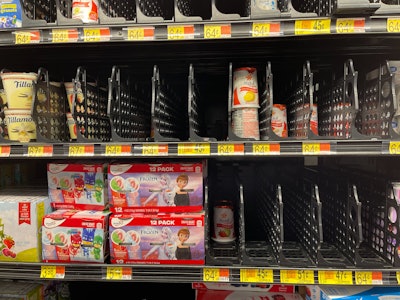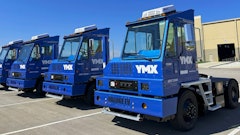
The New Normal… a phrase created shortly after the pandemic to signify the new way of doing business.
But for many supply chains, that “new” way of doing business changes constantly, forcing decision-makers to continuously pivot.
In Food Logistics’ Nov/Dec 2022 issue, editor-in-chief Marina Mayer talks with industry experts about what the return to normalcy in the supply chain space looks like and what’s in store for global cold chains come 2023.
Here’s an interview with Mirko Woitzik, global director, intelligence solutions at Everstream Analytics, who details why supply chain disruptions will continue in 2023, with excerpts publishing in Food Logistics’ Nov/Dec 2022 issue. [CLICK HERE to read the article in full].
Food Logistics: 2022 saw a lot of instability within the supply chain. Port strikes, rail strikes, driver shortage and more. Industry experts even predict it may take supply chains close to 2-3 years to turn around. From your vantage point, what does the state of the supply chain look like next year and the years ahead?
Mirko Woitzik: The supply chain will likely continue to face disruptions in 2023, impacting industries in logistics, manufacturing processes, raw material and labor supply.
Looking at the years ahead, logistic disruptions are sure to continue. As long as COVID-19 is a threat, some countries will continue to lock down entire cities to stop a surge or outbreak in cases. For example, China continues to adopt a zero-COVID policy that can partially or fully lock down major cities like Chengdu, Shenzhen, Xian, or Shanghai. While this persists, we will continue to see port, airport, and city shutdowns, as well as extended travel bans which will impact supply chain logistics.
The global economic slowdown and rising inflation rates will also create workforce and labor issues within the supply chain. This will add financial pressure to many parts of the supply chain that are still reeling from the impacts of COVID-19 coupled with the war in Ukraine. Cost-cutting measures will likely increase labor shortages in critical parts of the supply chain from food production to ports and railways, which have the potential to cause further turmoil.
Food Logistics: What are some of the main trends or challenges set to disrupt supply chains in 2023 (be specific)?
Woitzik: Currently, we are facing three head winds, which will carry into 2023. Namely, COVID-19 lockdowns in China, the war in Ukraine and climate change.
COVID-19 lockdowns. Future COVID-19 lockdowns in China will continue to lead to supply chain disruptions from two fronts, logistics and production delays.
While authorities in China are willing to sacrifice the economy in order to maintain zero COVID-19 cases, lockdowns will continue to be a major challenge for managing supply chain logistics. 2023 will likely see disrupted transportation modes resulting in delayed shipments. In addition to logistic disruptions, companies will be forced to shut down factories, affecting production output and creating production delays.
Russia-Ukraine War. Russia cutting off gas supplies to many parts of Europe is greatly affecting the price of energy in Europe. Currently, Europe is facing 10% inflation as of September 2022. Moreover, the Russia-Ukraine War does not appear to be ending soon, and we will likely see inflation soar even further during the winter months. The increase in costs has resulted in companies in Europe either shifting their production to other parts of the world or reducing their output. In some cases, companies that cannot afford it had to close, or stop production entirely. These problems will not be an overnight fix and will surely continue to be an issue into the new year.
Climate change. The impact of climate change has again become visible this year and will continue impacting supply chains in 2023. With extreme weather predicted to continue and escalate into the new year, heatwaves, drought, and damaging hurricanes will cause significant disruptions. In 2022, we saw how heatwaves in many parts of the world led to low river levels and had impacts on manufacturing and agricultural supply chains. In China, low river levels caused multiple production stoppages in Sichuan and Chongqing. These regions rely heavily on hydroelectricity and as a result, damaged thousands of crops across Central China. In Germany, the low water levels at the Rhine caused disruptions to the chemical industry. The Rhine River is a major waterway used to transport upstream and downstream chemical products. Hurricane Ian earlier this month resulted in power outages and disrupted agricultural and food production Florida which has in turn impacted prices for critical ingredients such as oranges.
Food Logistics: The cold food chain continues to face a host of risk/security challenges. What can companies be doing now to adapt for the future?
Woitzik: The cold food chain continues to face risks such as equipment malfunction like power outages and coolant/refrigeration failure), lack of standard or uniform infrastructure such as lack of proper warehousing, cooling options and temperature-controlled facilities. Other risks include human error such as improper handling of goods and theft.
There are some measures companies can adopt for the future including actively using real-time weather analytics for critical shipments. This will help forecast temperatures that allow customers to choose the most cost-effective mode of transportation.
Food Logistics: Drones, autonomous vehicles and other cutting-edge technologies are making headlines in logistics. How do they impact the future of supply chains?
Woitzik: Drones and autonomous vehicles lead to improvements in supply chain in terms of access, time and speed. Both tools can help to reduce certain labor bottlenecks. For example, autonomous vehicles help with inventory management in warehouses, as well as by automating warehousing processes and reducing workplace accidents.
Nevertheless, as supply chains become more digital, there is also the possibility of increased cyberattacks in the supply chain. With more automation, the propensity for hackers to infiltrate company systems increases, leading to potential downtimes.
Food Logistics: Sustainability continues to be a core part of many companies’ supply chain strategies. What’s most important in achieving that ultimate sustainability footprint?
Woitzik: It is critical that a sustainability strategy adopts a holistic approach by looking at both environmental, social and governance issues throughout the supply chain. Companies need to look at environmental, social and governance (ESG) topics both from a procurement, supply chain planning and logistics perspective. Monitoring, assessing and collaborating with sub-tier suppliers and partners will be key to achieving a better sustainability footprint.
This is the approach that new supply chain due diligence laws in Germany, and more broadly, the European Union, have been taking. Also, new laws such as the Uyghur Forced Labor Prevention Act have been placing the responsibility on the importing company to ensure that no forced labor is used in manufacturing the goods. As a result, end consumers are increasingly demanding awareness of sustainable supply chains, which will impact consumer choices in the future.
Food Logistics: The influx of e-commerce put supply chains in the spotlight to pivot or fall behind. What can companies do to re-tool their warehousing and transportation tactics?
Woitzik: Warehousing. Companies can consider collaborating with reliable suppliers to ensure there is enough inventory. They can also try to harness data from purchases made and then analyze trends in consumer preferences. Another option is to pivot towards drop ship, where manufacturers send products directly to consumers, while retailers act as the middleman.
A benefit to e-commerce is that companies can analyze real time inventory. Additionally, companies will know when to produce or order products, which also reduces the risk of out-of-stock products and overstocks.
Transportation. Companies can consider collaborating with freight forwarders, expanding the current transport fleet and consolidating orders before shipping it out. This helps reduce delivery or transportation delays and increases the visibility of customers. Moreover, with an expansion in transportation, there will be an exchange of documentation online between the supplier and the customers. This allows for a more efficient way to fulfill orders for the transportation business.
[CLICK HERE to read the article in full].



















